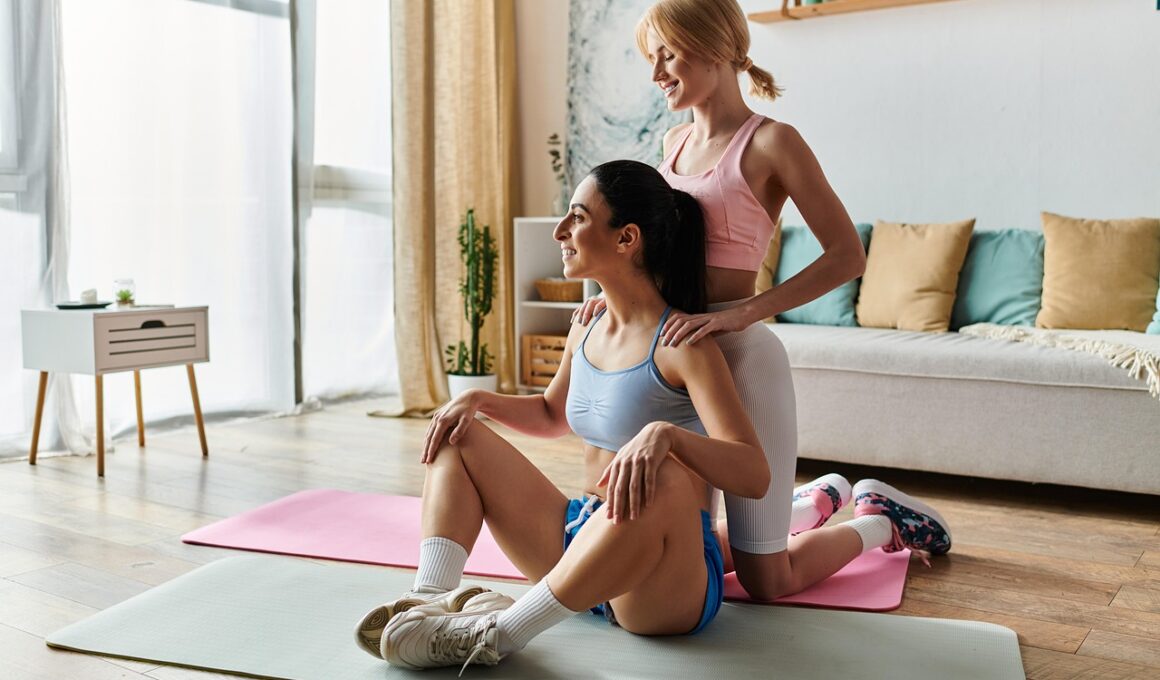Compression Wear: Benefits and How to Choose the Right Fit
Compression wear has gained significant popularity among women dedicated to fitness. This specialized clothing offers numerous advantages that enhance overall performance. Firstly, compression garments improve blood circulation, which is crucial during workouts. Enhanced circulation provides an optimal oxygen flow to the muscles, reducing fatigue. This effect allows fitness enthusiasts to endure longer and more intense workouts, pushing their limits effectively. Additionally, compression wear is known to minimize muscle soreness post-exercise, aiding recovery. The tight fit firmly supports muscles, which, in turn, reduces the risk of injuries. Furthermore, compression clothing may help to regulate body temperature by wicking away perspiration. As a result, wearers are left feeling comfortable and dry, enabling better concentration on their routine. To gain these benefits, it is essential to choose the right compression wear for your specific activities. Opting for fabrics that are durable and breathable ensures longevity and comfort during your workouts. Always remember to check the sizing guidelines for an optimum fit that meets your needs, as the right compression fit varies based on body type and workout intensity.
Understanding Compression Wear
Compression wear is designed to fit tightly against the skin, offering varying levels of support based on the garment’s style and purpose. Broadly categorized into categories, these garments include tops, bottoms, and specific items such as sleeves and socks. Compression tops provide upper body support, aiding in posture and stability, crucial during intense activities. Compression bottoms, ranging from leggings to shorts, offer lower body support, reducing muscle vibration during high-impact workouts. This makes them particularly advantageous for activities such as running or cycling. Sleeves designed for arms and calves help isolate compression to specific muscle groups, catering to targeted support for varied workouts. Choosing the right compression garment can greatly affect performance, minimizing discomfort and improving efficiency. Always consider purchasing from reputable brands specializing in athletic wear, as the quality of construction and fabric plays a significant role in the effectiveness of compression. Features like moisture-wicking properties will enhance comfort, while seamless designs reduce chafing during exercise. A well-chosen compression item not only boosts athletic performance but also helps promote a healthy body while maintaining style in your workout gear.
The choice of compression wear can considerably influence workout results, and factors like fit, fabric, and purpose must be considered. When selecting compression garments, size is critical to ensuring the ideal level of support. A snug fit is necessary, but it shouldn’t be overly tight or restrictive, as that can lead to discomfort during workouts. Typically, compression clothing is available in variegated sizing options, making it essential to refer to size charts that different brands provide. It’s also crucial to try on items and ensure ease of movement. Additionally, the fabric is a vital element to consider when choosing compression wear. Look for breathable materials that wick moisture away from the body to stay comfortable during workouts. Fabrics like nylon and spandex commonly found in compression items not only provide stretch but also ensure durability. Depending on your activities, various compression levels may be recommended; for example, higher compression levels may be suitable for heavy lifting. Always remember to listen to your body; if discomfort arises, reassess your garment choice to enhance your workout experience.
Impact on Performance
One of the primary advantages of compression wear is its positive impact on overall performance in various physical activities. When muscles are supported and receive adequate blood flow, they function more efficiently, translating to better workout results. Specifically, compression garments can lead to a lower perceived level of effort, as fatigue sets in slower during intense training. Athletes often report enhanced endurance, allowing for longer workouts and improved performance over time. This wear can also contribute to faster recovery times after intense sessions, which allows athletes to maintain their training regimens without experiencing prolonged soreness and fatigue. Moreover, the psychological effects of wearing compression gear should not be ignored. Many athletes feel more confident and secure when adequately dressed, paving the way for better performance. They believe that performance gear like this allows them to push harder and achieve fitness goals with more dedication. The right compression wear can help enhance motivation levels and set a positive tone during workouts. Additionally, as many women transition workouts into social spaces, stylish compression options lead to additional confidence!
Wearing compression clothing can significantly enhance post-workout recovery, which equals better performance over time. After an intense workout, muscles can experience micro-tears, leading to soreness and swelling. Compression wear mitigates this effect by providing graduated compression, encouraging blood circulation and reducing swelling effectively. This is vital for recovery as nutrient-rich blood reaches the muscles faster, enabling quicker healing. Faster recovery allows athletes to return to their routines sooner without enduring the consequences of delayed onset muscle soreness (DOMS). Research supports the claim that a well-designed fit can lead to reduced recovery time, allowing fitness enthusiasts to engage in their preferred activities more frequently. Individuals aiming to improve fitness levels should consider integrating compression wear into their post-workout routines proactively. Additionally, the versatility of compression garments allows them to be worn during warm-ups, workouts, and cool-downs, making them an economical choice for all fitness ladies. The increased comfort and support provided by compression gear motivate women to stay active, which is crucial for thriving in fitness communities. Always care for your compression gear; follow washing instructions to maintain elasticity and performance benefits.
Choosing the Ideal Compression Wear
Choosing the ideal compression wear requires thoughtful consideration tailored to individual preferences and workout types. Firstly, assess your primary fitness activities. Will you be participating in low-impact workouts such as yoga, or high-intensity training like running? For low-impact activities, lighter compression garments may suffice; however, for high-intensity workouts, stronger compression is advisable to support muscles fully. Next, prioritize the fit; many brands offer various cuts and styles that cater to diverse body types. Seek options that provide maximum support yet do not restrict movement, offering comfort during workouts. Evaluating customer reviews can assist in selecting high-quality options that perform well during exercise. Material choice plays a pivotal role as well. Ensure that the garments are constructed from moisture-wicking and breathable fabrics to keep the body cool and dry. Lastly, consider design elements such as practicality and aesthetics. Chic designs motivate wearers to embrace their workouts more vigorously! Ultimately, investing in quality compression wear can yield substantial returns in performance, recovery, and overall enjoyment in your fitness journey, making it a vital element of women’s athletic gear.
In recent years, compression wear has evolved beyond its functional qualities, offering fashionable options for women in the fitness realm. Athletes seek gear that looks stylish while providing comfort and performance, resulting in a market flooded with colorful prints, patterns, and creative designs. The visibility of stylish wear has made it a common sight, transitioning from gym attire to casual everyday clothes. Women wear compression leggings and tops all day due to their comfort and trendy appearances, confidently showcasing their fitness investments! This shift in view has developed a fusion of athleisure style, where women feel empowered to wear their sporty looks confidently in various social settings. As popular influencers and athletes showcase their compression wear in vibrant styles across social platforms, it inspires a broader acceptance of athletic wear as normal clothing, not confined to the gym. Additionally, brands are responding by developing collections that balance aesthetics with functionality, emphasizing fit, feel, and performance. This evolution signifies a growing shift in perspective around women’s fitness gear and its role in promoting a healthy lifestyle, enabling personal expressions while pursuing fitness goals.
In conclusion, investing in quality compression wear provides a competitive edge in women’s fitness while ensuring comfort and style. These garments boast undeniable benefits such as enhanced performance, effective recovery, and chic designs that allow athletes to feel confident. Choosing the right compression clothing plays a vital role in maximizing these benefits; understanding sizing and fabric advancements will help narrow down reliable options. Women dedicated to their fitness journey deserve to perform at their best, while also enjoying the appealing aesthetics of modern workout gear. As compression wear continues to evolve, it offers possibilities to embrace personal style while prioritizing health and wellness. Investing in high-quality options ensures that ladies are well-prepared for their Routines. As styles and technologies develop, the realm of compression wear will likely see exciting innovations that further enhance athletic performance. Thus, consciously selecting the right compression garments is essential for those looking to excel in their fitness pursuits. Embracing the unity of stylish comfort and performance gear not only fosters motivation but also empowers women to embrace their athletic journeys positively.


